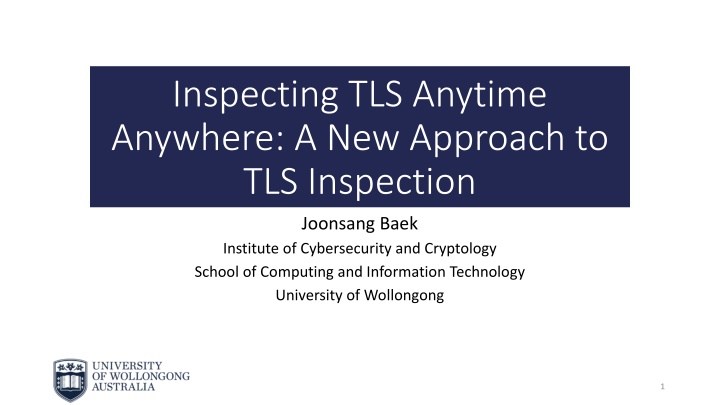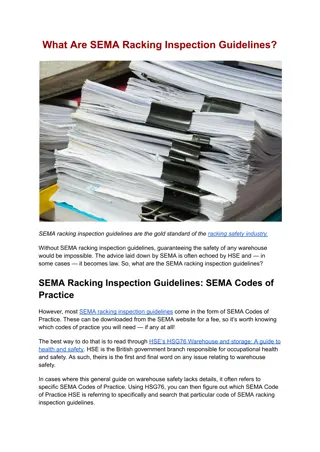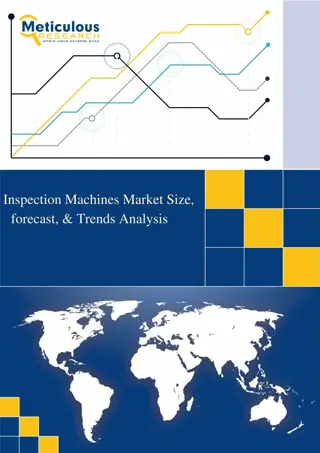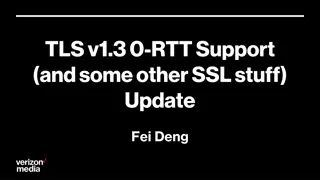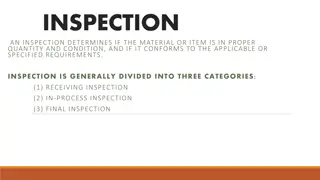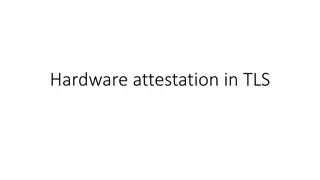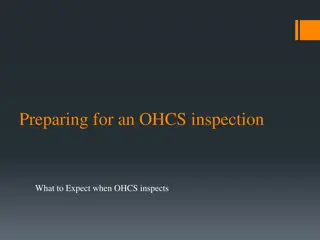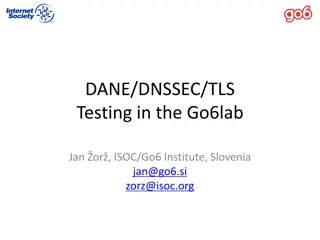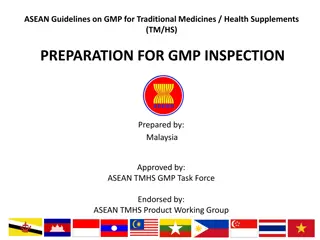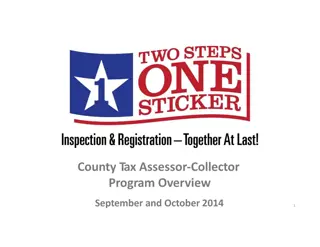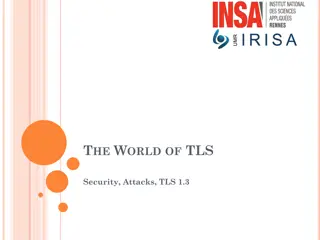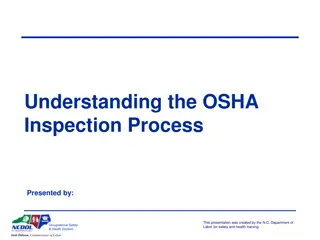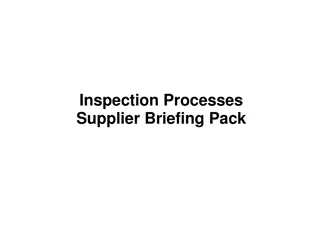A New Approach to TLS Inspection
This article explores a new approach called IA2-TLS for inspecting Transport Layer Security (TLS) anytime and anywhere. It discusses the primary goals of TLS, the increasing importance of data encryption over networks, and the need for TLS inspection to enhance security controls. The challenges of implementing controls along the encrypted channel are highlighted, along with previous approaches like TLS Inspection Proxy and MITM style inspection. The benefits, features, analysis, and applications of IA2-TLS are also discussed, emphasizing the significance of securing communications between clients and servers.
Download Presentation

Please find below an Image/Link to download the presentation.
The content on the website is provided AS IS for your information and personal use only. It may not be sold, licensed, or shared on other websites without obtaining consent from the author.If you encounter any issues during the download, it is possible that the publisher has removed the file from their server.
You are allowed to download the files provided on this website for personal or commercial use, subject to the condition that they are used lawfully. All files are the property of their respective owners.
The content on the website is provided AS IS for your information and personal use only. It may not be sold, licensed, or shared on other websites without obtaining consent from the author.
E N D
Presentation Transcript
Inspecting TLS Anytime Anywhere: A New Approach to TLS Inspection Joonsang Baek Institute of Cybersecurity and Cryptology School of Computing and Information Technology University of Wollongong 1
Contents Introduction to TLS TLS Inspection Previous TLS Inspection Approaches Our Approach to TLS Inspection: IA2-TLS IA2-TLS: Benefits, Features, Analysis and Applications Conclusion 2
Introduction to TLS Primary goals of TLS: To provide a secure channel between a client and a server. Handshake Protocol Responsible for authenticating communicating parties, negotiating cryptographic modes and parameters and establishing shared key. Record Protocol Uses the parameters established by the handshake protocol to protect traffic between the communicating peers by providing data confidentiality and integrity. 3
Introduction to TLS Data encryption over the network is almost a must The percentage of HTTPS page loadings (in the Chrome browser) increases from 67% in May 2017 to 90% in May 2019 in the US. Now, among the top 100 non-Google sites on the Internet, 96 websites support HTTPS and 90 websites set HTTPS as default. Transport Layer Security (TLS) or SSL is the standard protocol for HTTPS to provide confidentiality and authentication services. 4
TLS Inspection Needs Not only regular users but also threat actors can get benefit from TLS by hiding their activities using it. More and more organizations are interested in setting up security controls over TLS traffic to conduct activities such as intrusion detection, filtering and enforcing compliance with corporate policies. 5
TLS Inspection Because TLS provides an end-to-end encrypted channel by nature, it is impossible to implement such controls along the path of the network. Solution TLS Inspection 6
Previous Approaches to TLS Inspection TLS (Inspection) Proxy MITM (Man-In-The-Middle) style inspection Decrypt Encrypted traffic Encrypted traffic Encrypted traffic Encrypted traffic TLS Proxy Client Server 7
Previous Approaches to TLS Inspection What are the problems? Management of TLS proxy certificate This makes it possible for the client to establish an encrypted connection to the proxy rather than the intended web site. Need to distribute TLS proxy certificate to all users However, this can be a source of other problems. 8
Previous Approaches to TLS Inspection The proxy needs to decrypt and re-encrypt the traffic in real time to conduct the MITM attack Performance degradation in terms of computation and communication is always expected. If a non-real time inspection such as post-incident review (PIR) is required, a completely different method should be employed. 9
Previous Approaches to TLS Inspection Other middlebox approaches: Deep Packet Inspection (DPI) over encrypted traffic Matching keywords (detection rules) without decrypting the whole traffic User privacy retained! However, the problem is that heavy computations are required in the setup stage or it has a long detection time. 10
Yet Other Approaches Alternative methods without depending on middleboxes In an extreme case, there was an attempt to obtain the server s private key. Downgrading cryptographic components in TLS such as forcing the peers to agree on weak TLS cryptographic primitives such as Dual_EC_DRBG , a weakedn PRG. . 11
Our Approach: IA2-TLS IA2-TLS makes the encrypted traffic transparent (i.e., decrypted) to the network node acting as an IA2- TLS Inspector. 12
Our Approach: IA2-TLS The possession of inspection key guarantees the inspection capability. As long as this key is kept secret, the encrypted traffic will not be compromised. 13
IA2-TLS Benefits Efficient inspection No degradation of performance Not depending on the MITM-style TLS proxy No need to worry about how the TLS proxy handle certificates of the servers: In the TLS proxy inspection, the client has no visibility into what CAs the TLS proxy trusts. Offline (as well as online) inspection 14
Design Principles of IA2-TLS Minimal modification We wanted to avoid a dramatic modification of the TLS protocol to keep all its functionality. IA2-TLS only slightly modifies the handshake protocol, and the rest of the protocol is identical to those of TLS. IA2-TLS is based on TLS 1.2 (Possible to be extended to TLS 1.3) 15
Design Principles of IA2-TLS Inspection key The inspectorcreates a uniform inspection key . We combine it together with the random nonces generated by the client and the server( at the beginning of the TLS handshake protocol) to generate a random coin, which will be used to create a pre-master secret (PMS) in the TLS protocol. 16
Design Principles of IA2-TLS The inspection key has the capacity to recover the PMS without using the server s private key. The size of the inspection key should reflect the security level the most of modern symmetric key cryptosystems should provide: 128 bits or 256 bits. The lifetime of the inspection key depends on the policy, but it should not be used for an extended period. 17
Design Principles of IA2-TLS PMS recovery through a random ephemeral value (REV) Key Encapsulation Mechanism (KEM): An essential cryptographic primitive used in TLS to generate the PMS, which the client and server will use to derive subsequent (symmetric) keys to encrypt their application data after a handshake. 18
Design Principles of IA2-TLS For example, the Diffie-Hellman key exchange used in TLS can be described as a KEM scheme that encapsulates the server s public key y=gx into a PMS, yr for the REVr, and a corresponding ciphertext (CT), gr, which should be contained in ClientKeyExchange. 19
Design Principles of IA2-TLS As said earlier, we generate a REV used for randomization using the inspection key together with the client and server s random nonces. If the randomized KEM scheme has the property that the key generated by its encapsulation algorithm can also be recovered using the REV only (not through the decpaulation algorithm), the inspector will be able to obtain the same PMS. 20
Threat Model Adversary A A aims to obtain any information about the target client and server s PMS or master secret (MS). Adoes not have access to the current inspection key nor the private key of the server. The adversary is an intruder to the client s browser, which is known to run IA2-TLS. By making the browser choose a static (not freshly random) value for C, the adversary may get some information about PMS. 24
Security Model IA2-TLS-KEM A KEM scheme extracted from the IA2-TLS handshake 25
Security Model CCA notion Here, the adversary A is very powerful: We allow A to access to decapsulation oracle. We allow A to choose any client random nonce C and query it to the encapsulation oracle. This notion reflects the threat model. 26
Security Analysis Security Result: The IA2-TLS-KEM scheme is IND-CCA secure if the underlying randomized KEM scheme is OW-PCA secure, and H and KDF are random oracles. Implication As long as the server (honestly) generated its random nonce S and H is a random oracle, the PMS from IA2-TLS does not leak any information to the adversary. 27
Implementation System overview 28
Implementation Implementation of IA2-TLS Client We implemented IA2-TLS Client on the Google Chromium browser (Version 76.0.3782.0, Developer Build, 64-bit). For SSL/ TLS communication, the Chromium browser uses BoringSSL, which is a fork of OpenSSL. We modified the generation of PMS in BoringSSL to implement IA2-TLS Client. 29
Implementation PMS for the RSA-KEM This is generated by calling RAND_bytes function from BoringSSL. We replaced this function with a PRF which takes the inspection key , the client random c and the server random S as input. That is, PMS = PRF( ?, c|| s) 30
Implementation PMS for the ECDHE The function Offer is a function that generates a REV for the client, which is the exponent rof client s CT value, i.e. gr. We modified the Offer function to take hs->ssl, which contains all the necessary values including client random and server random as input. We used a PRF function (tls1_prf) to generate the client private random value r, i.e., r= PRF ( ?, c|| s) 31
Implementation Implementation of IA2-TLS Inspector The aim of IA2-TLS Inspector is to enable an inspector to decrypt and look into the TLS traffic without receiving any auxiliary information from the client or the server. In order to achieve this, the inspector should be able to produce the same PMS (and hence MS) by applying the inspection key to the captured TLS traffic. 32
Implementation We implemented IA2-TLS Inspector using the BoringSSL library. IA2-TLS Inspector can be a non-real-time or real-time agent, which needs functionalities of capturing and analzying the TLS traffic. We used tshark to capture the TLS traffic. 33
IA2-TLS Compliance Situation: When IA2-TLS is deployed in IDS to inspect the organizational network, the company may want to know whether their employees access to HTTPS websites using the browsers that support IA2-TLS before they connect. 34
IA2-TLS Compliance Naturally, IA2- TLS offers this capacity as follows. Note that the TLS handshake is completed after client and server exchange Finished messages. The IDS can capture those messages and check whether the key used to encrypt the Finished messages is equal to the key derived from the IA2-TLS protocol using the inspection key, and the client and server random nonces. If the equality does not hold, the IDS can terminate the connection to protect the system from unmonitored traffic. 35
IA2-TLS Compliance When the ECDHE is used, the IDS can verify the user s noncompliant behavior by observing the CT-value (gr), which is included in ClientKeyExchange, instead of decrypting the Finished message. This reduces the computational overhead required to detect the monitoring bypass. 36
Support for TLS 1.3 Question: Can IA2-TLS be extended to TLS 1.3? Possible because 1) the client random nonce is produced; 2) the ephemeral DH (DHE) key encapsulation is still supported. 37
Support for TLS 1.3 TLS v1.3 handshake protocol (in a nutshell) The client sends the ClientHello message to the server, which includes: client random nonce C. a list of cipher suites that the client supports key_share gr 38
Support for TLS 1.3 Upon receiving the ClientHello message, the server responds with the following ServerHello message, which includes server random nonce S; a selected cipher suite; and key_share gs After the client and the server have exchanged the key_share value, both parties can come up with traffic key= HKDF(grs, aux ) 39
Support for TLS 1.3 Our observation The client should send key_share gr to the server before it receives the server s random nonce S in TLS 1.3. We cannot make use of S but can use only the client nonce C to generate the REV r. We should compute r H( ?, C), where ? is the inspection key. As the inspector can recover r, it can also reconstruct the traffic key. Inspection is possible! 40
Support for TLS 1.3 The effect of the absence of the server random nonce This will make the adversary A in the IND-CCA notion for IA2-TLS-KEM weaker as now, the adversary might control the generation of r somewhat more easily. (For example, A can choose non-uniform C.) Therefore, we should make the attack game in such a way that A has no longer has the ability to choose the client random nonce and fix it as a uniform random string. 41
Support for TLS 1.3 We proved that the IND-CCA security of the above KEM (IA2-TLS1.3-KEM) under this weakened security model. Remark: Nevertheless, IA2-TLS based on RSA will no longer be possible as RSA-KEM is not supported in TLS 1.3. 42
Future Work Implementation of the IA2-TLS 1.3 Implementation of a real-time inspector that integrates the inspector program into an IDS IA2-TLS plug-in for the browser 43
Controversy Rather Than Conclusion Is TLS inspection good? We embrace the controversy: There is a privacy concern for the TLS inspection. Do we have to sacrifice user privacy for safety or security? How much do we trust the admin that does inspection? 44
Controversy Rather Than Conclusion Is it another example of offensive use of cryptography Moti s comment on Test of Time Award he received from S&P: Cryptovirology: Extortion-Based Security Threats and Countermeasures Adam L. Young, Moti Yung, 1996 45
Controversy Rather Than Conclusion But still it s much better for the research community to publish the result on TLS inspection than some agency or a private company does it secretly. 46
